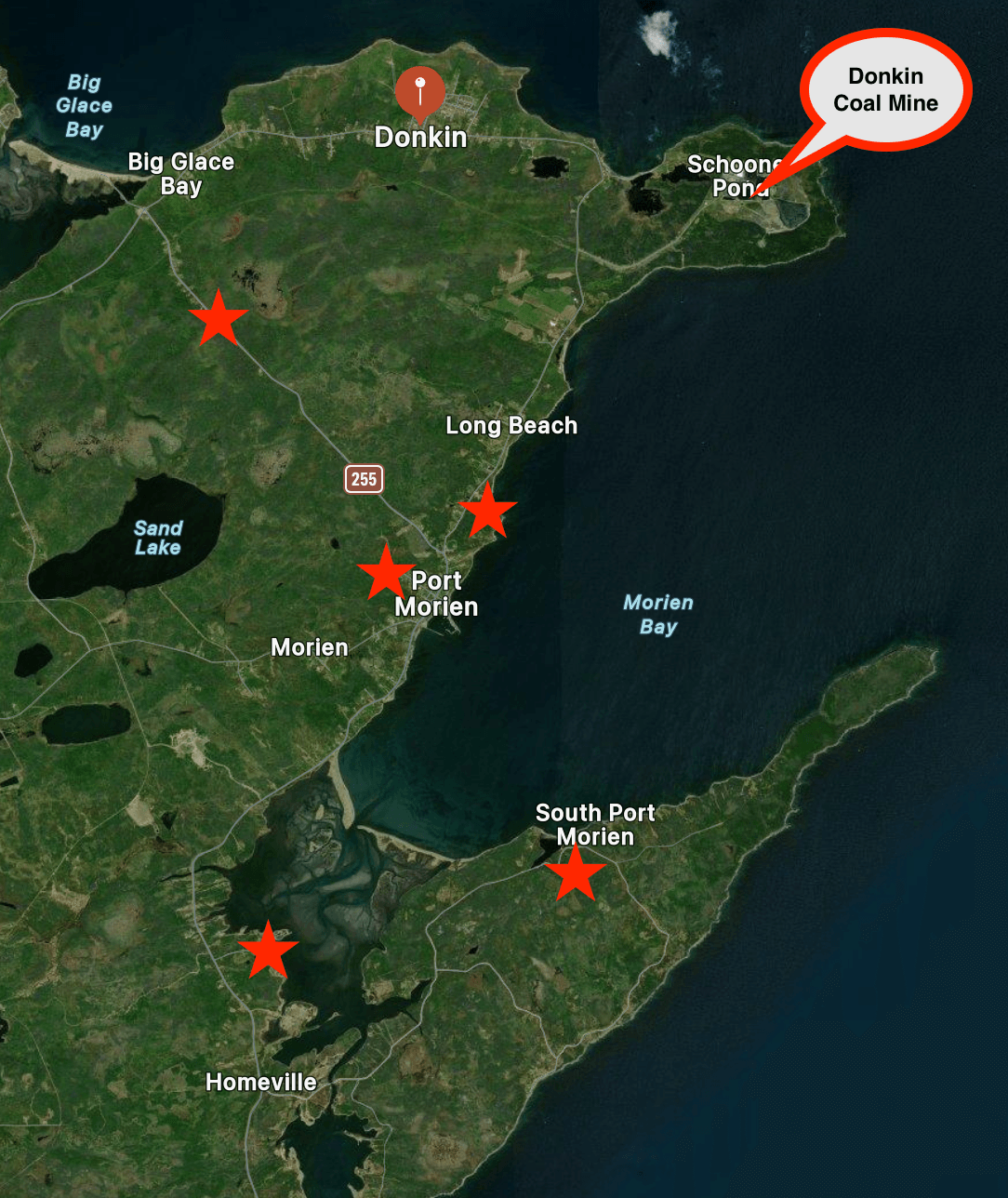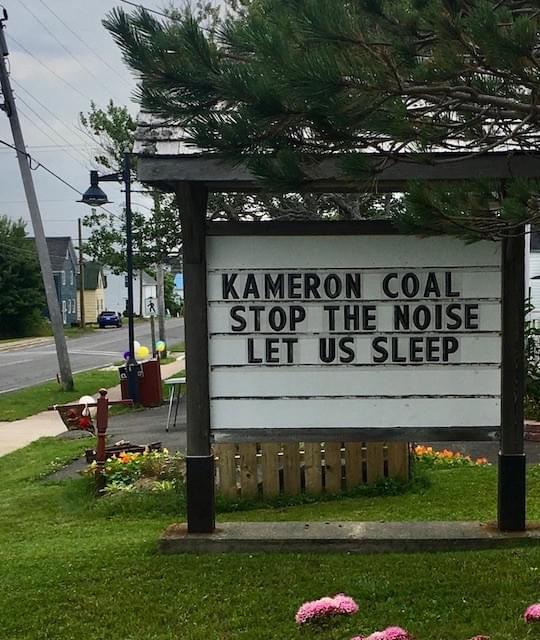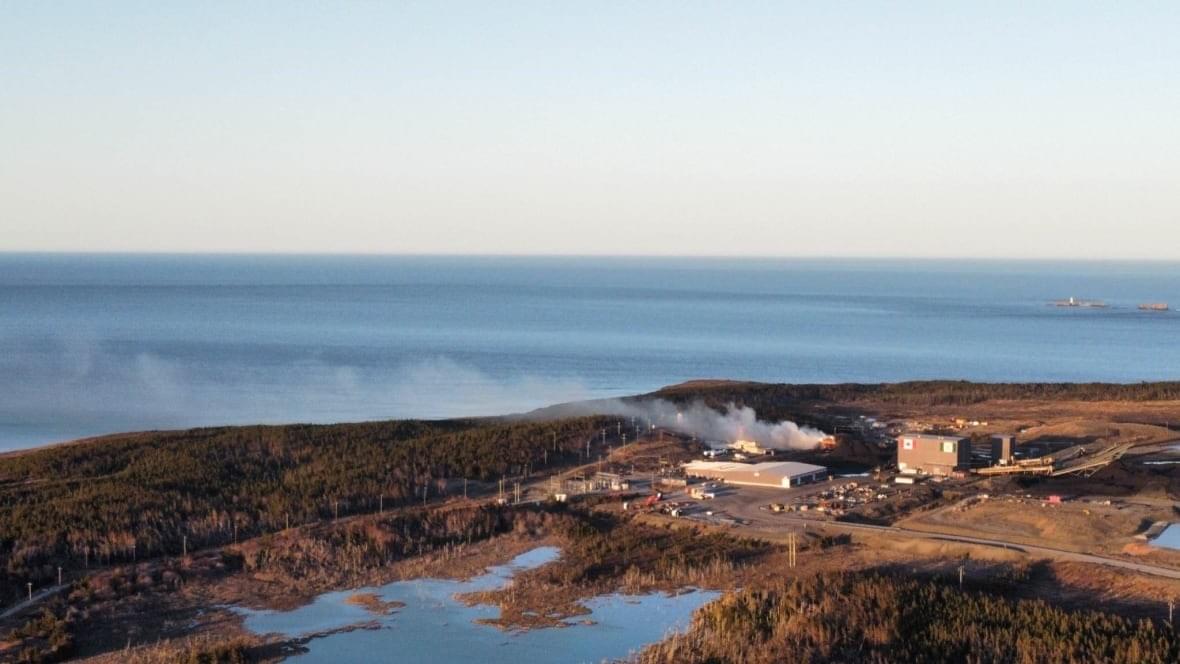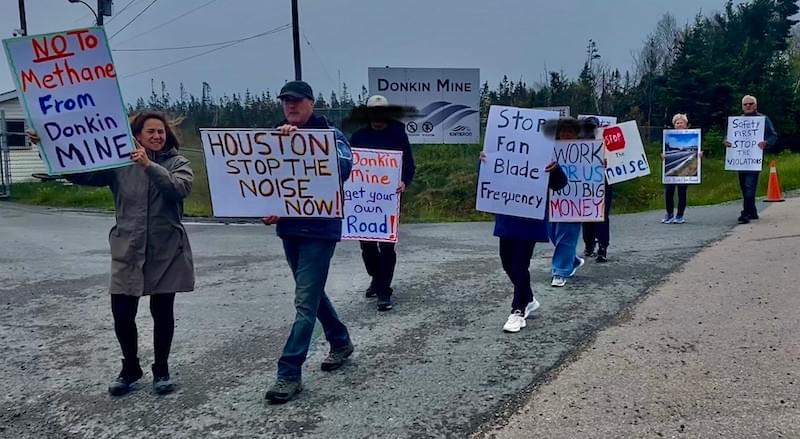There’s a low industrial hum hanging in the air in Port Morien, Cape Breton, Nova Scotia. It cuts through walls and windows, sinks into bedrooms and keeps people up at night. For over five years now, that droning noise has been the background to daily life in the small coastal communities around the Donkin underground subsea coal mine.

The Donkin coal mine on a map.
The Donkin mine, with tunnels extending beneath the Atlantic Ocean, has been plagued by safety issues and environmental concerns since it first started production in 2017. Although it has been sitting idle since July 2023, two massive ventilation fans continue to push methane from its underground tunnels into the open air. With them comes the sound: an inescapable ‘pure tone’ (a specific low-frequency sound that is especially disruptive and difficult to dampen) that residents describe as a source of sleep disturbance, anxiety and stress.
Droning on and fighting back
Living seven kilometres from the mine, Catherine Fergusson was the first to take initiative against the persistent hum that had just started infiltrating homes in Port Morien and surrounding areas. When the noise first began in 2019, she reached out to her neighbours to ask: Are you hearing this, too? The responses she received painted a clear picture: those living within a seven to 14 km radius were deeply disturbed, and nothing was being done about it.
That initial conversation led to the formation of the Cow Bay Environmental Coalition (CBEC), a grassroots group determined to address the noise from such industrial activity and advocate for the health of local residents affected by it. Many of its members — retirees, longtime community members, one in their 90s! — were entirely new to advocacy. All shared the understanding that this noise pollution was not just a nuisance, but a public health crisis.
The CBEC began by writing letters, collecting noise complaints, publishing articles in newspapers, appealing industrial approvals and meeting with decision-makers (such as the province’s former Environment and Climate Change minister in 2021). They consulted with a UK-based company specializing in industrial noise and vibration who confirmed it was a pure tone — the worst the company had seen in over 30 years — and that any competent person would expect community complaints. They continuously called on the Nova Scotia government to conduct independent sound monitoring and implement proper mitigation, but to no avail.
Despite years of effort, the issue remains unresolved. Residents continue to experience severe health impacts. These range from panic attacks, depression and anxiety to stress-induced premature aging, severe headaches, balance disorders and even decreased cognitive abilities. Some have resorted to sleeping in basements. One family has sold and left their home altogether.

A sign reads: ‘KAMERON COAL - STOP THE NOISE - LET US SLEEP.’
The coalition’s central demands have always been clear: an end to the noise and a meaningful response from the provincial government. Over time, their advocacy has also raised a broader question: why is this disruptive coal mine still allowed to operate at all, especially when it doesn’t even serve Nova Scotia’s energy needs?
A government out of tune
The community surrounding the Donkin mine has a long history of coal mining. The mine itself is privately owned by Kameron Coal (a subsidiary of U.S. coal producer The Cline Group), but its noise regulation and approval fall squarely under provincial jurisdiction. However, the government has for years evaded responsibility, offering hollow assurances and ignoring CBEC’s technical reports, mitigation proposals and lived experiences.
CBEC has also highlighted the Donkin mine’s broader environmental toll. The mine extracts metallurgical coal, which emits more greenhouse gases per ton than thermal coal. Its continued operation makes it virtually impossible for Nova Scotia to meet its target of reducing greenhouse gas emissions by at least 53 per cent below 2005 levels by 2030.

Smoke billows from an underground fire at the Donkin mine (Daniel Dillon/Facebook).
The mine’s negative impacts extend far beyond its auditory and environmental footprint. CBEC members have raised concerns about the ecological risks of methane emissions. The extracted coal is low quality, and the mine’s record includes over a dozen roof collapses in just a few years, raising safety concerns for workers. To add insult to injury, the mine’s output is exported overseas, meaning that Nova Scotians are left with all of the pollution but none of the energy itself.
What’s more, Kameron Coal remains publicly silent as it now sits idly for two years. Neither Catherine and her fellow CBEC members, nor the larger Port Morien community, have been made aware of what the future plan is for the mine.
Turning up the volume
Earlier this year, the coalition decided it was time to make the noise impossible to ignore. Each Thursday from February 27 to March 20, Catherine organized and led a series of demonstrations outside the Nova Scotia Provincial Building in Sydney. During each protest, a recording of the Donkin mine hum was played through speakers for 11 minutes, serving as a visceral reminder to passersby and public officials of what it feels like to live next to unchecked industrial noise.
These protests caught the attention of newly elected municipal councillor Steven MacNeil, who visited a local resident’s home to experience the noise himself. Following that visit, MacNeil invited the CBEC to present at city council.
On June 10, Cape Breton Regional Municipality unanimously passed a motion in support of the coalition. After years of organizing, residents finally saw formal recognition of the harm they had been living with for so long.
“[The acceptance of the motion of support was] something I hadn’t experienced before,” Catherine shares. “[It sent] a message that our health and wellness matters.”
The council may soon follow up with a formal letter to the government on behalf of affected residents, which is a small but significant gesture toward healing and solidarity. Still, immediate action remains elusive. No concrete steps were outlined during the council’s motion. Catherine believes any meaningful progress will require continued dialogue and pressure, not just symbolic support.
The sound of resistance
The Donkin mine is arguably a symbol of what’s broken. It’s an aging coal operation that endangers both people and planet, kept alive by inertia and political convenience. It’s also a constant, grinding example of what happens when fossil fuel interests are protected at the expense of real people’s lives.
But the coalition forming around it offers a vision for what’s possible: collective care, intergenerational advocacy and grassroots organizing that prioritizes community health and environmental responsibility. CBEC’s work shows how ordinary people, even with no organizing or advocacy experience, can band together and make their voices equally steady and impossible to tune out.
For Catherine and her fellow advocates, the work ahead goes beyond ending the industrial hum. It means holding systems accountable, redefining public health to include environmental well-being and refusing to be sidelined by government inaction.

Residents rally in front of the Donkin mine with signs denouncing its methane emissions and fan blade frequency. One sign calls on Nova Scotia Premier Tim Houston to ‘stop the noise now.’
The coalition continues to bring awareness to the adverse consequences of coal mining through demonstrations and actions. Presently, they’re focused on bringing a petition to the provincial legislature and to the Minister of Environment and Climate Change, Tim Halman, calling for immediate action to stop the tonal noise and an honest and accurate assessment of the mine’s noise impacts.
While the city’s support has been a key step, CBEC knows that real change will only come through sustained public pressure. They’ve joined forces with allies across Nova Scotia to amplify their calls and situate this local fight in a broader movement for environmental justice.
They’re also expanding their impact: the Cow Bay Environmental Coalition recently joined Climate Reality Canada’s national Community Climate Hub network, working alongside other Hubs across the country to push for change through local organizing, advocacy and public engagement.
“This united voice will only grow stronger as time goes by,” Catherine says.
And in the shadow of a mine that tries to muffle protest, that voice is rising — not just louder, but unshakable, building a movement that won’t be silenced.
Learn more about Donkin mine noise advocacy efforts.
Listen to Catherine Fergusson speak about the Donkin mine in an episode of the Cross Border Network’s podcast series “Municipal Affairs.”